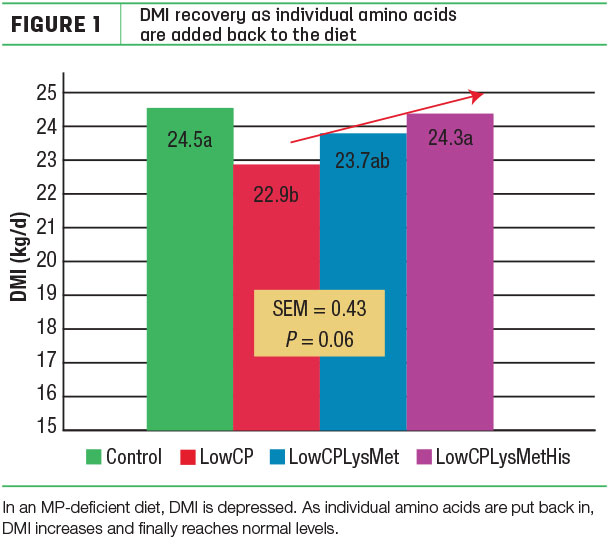Rumen-protected histidine is more of an attractive concept today than a commercial product. Yet experimental prototypes are showing potential. As these prototypes advance, factors related to their use and potential in dairy nutrition will gain more attention.
These factors include the forages fed, how consistently total mixed rations (TMRs) are mixed on-farm and environmental pressures.
The belief that histidine is a limiting amino acid in North America stems back to European data based on grass silage diets. More locally, Pennsylvania State University (Penn State) found consistently lower blood plasma histidine concentrations when conducting long-term trials with diets deficient in metabolizable protein (MP).
Histidine may be unique among the 10 essential amino acids for dairy cows. Residual histidine pools in the body provide a source of stored histidine during short periods of deficiency.
As with other essential amino acids, such as lysine and methionine, histidine cannot be created by dairy cows. Each must be supplied by feedstuffs. If requirements are not met, then an essential amino acid can literally limit production and performance and earn the name “limiting amino acid.”
Limiting amino acid
Research in amino acid supplementation by Penn State points to histidine as a limiting amino acid in dairy cows fed typical diets for North America – those based on corn silage, alfalfa haylage, corn grain and soybean or canola meals.
When rumen bacterial samples from various Penn State trials were analyzed, researchers found some 27 percent lower histidine than methionine concentrations in the microbial protein. Additional research may be required to confirm that microbial protein loses histidine with diets short on MP.
 Microbial protein is an increasingly important source of amino acids for dairy cows, if diets deficient in MP are fed. This suggests histidine may be a limiting amino acid in high-producing dairy cows fed diets short in MP. Recommendations for the proportion of histidine in MP range from 2.2 percent up to 3.4 percent.
Microbial protein is an increasingly important source of amino acids for dairy cows, if diets deficient in MP are fed. This suggests histidine may be a limiting amino acid in high-producing dairy cows fed diets short in MP. Recommendations for the proportion of histidine in MP range from 2.2 percent up to 3.4 percent.
Feeding strategies
Today, diets with a crude protein (CP) concentration of 16 percent or less are not uncommon on commercial dairies. Data from on-farm projects completed by extension and university research trials have found that diets often contain less than 16 percent CP and in some cases, less than 15 percent or even less than 14 percent CP.
Some of these low numbers may be explained by unrepresentative sampling, uneven mixing of the TMR or other factors that could affect diet composition. What is apparent is that high feed prices may result in diets with critically low CP levels.
The low CP levels may limit production in some herds. Before supplementing, know the ration’s existing amino acid levels and the herd’s actual dry matter intake (DMI). Rumen-protected lysine and methionine products are commercially available today and offer predictable and highly consistent amino acid levels.
Long term, low-CP diets can risk production losses from low histidine levels. In the short term, decreased levels of muscle elements containing histidine, such as carnosine and anserine, have been seen. A diet is considered low in CP when the diet is -5 percent on an MP basis for the production level.
Plasma hemoglobin could be used too, as it would supply 3.2 grams of histidine per day. Compared to other essential amino acids, histidine is unique in that it has additional endogenous labile pools. The depletion or replenishment of these pools over short periods may result in the negative effects of [low] histidine not being observed until 10-plus weeks of deficiency.
Energy balance
The first and most important factor for successfully reducing dietary protein to or below the animal’s MP requirements is to keep dietary energy balance at or slightly higher than the required level.
Amino acids are inevitably and ultimately used for glucose synthesis by dairy cows, but their role as an energy source to sustain production becomes more important when the diet is short in energy.
In many controlled experiments, diets with CP of around 14 percent are deficient in rumen-degradable protein (RDP), which appears as decreased digestibility of total tract neutral detergent fiber (NDF). Overall, data indicate that diets with RDP of around 9 to 10 percent of dietary dry matter (DM) decrease fiber digestibility. Keeping RDP greater than 14 percent is essential.
Supplementation
How much can MP be decreased before affecting production? In some cases, dietary CP as low as 12 percent did not affect milk production, although nutrient digestibility and microbial protein synthesis in the rumen were decreased.
In the 12 percent CP study, however, the dairy cows were low producers and intake was restricted. The important effect of protein on feed intake could not be demonstrated.
Penn State has conducted several amino acid trials with high-producing cows. The research has shown a variable effect of decreasing dietary CP on DMI. In trials where DMI was decreased when feeding diets deficient in MP, milk production also decreased.
In other trials, DMI did not decrease and milk production was no different than when diets contained adequate MP. However, total tract apparent NDF digestibility decreased by 6 to 20 percent.
Three factors appear to cause production losses with low-protein diets:
- Depressed DMI due to impaired rumen function or physiological regulation of intake
- Deficiency of RDP, which may cause decreased fiber digestion
- Insufficient supplies of key amino acids that limit milk protein synthesis (histidine may play a role in minimizing some of the negative production responses)
Big picture
Feeding diets with lower protein content carries several benefits. These diets reduce nitrogen input, improve the efficient use of nitrogen and reduce nitrogen losses from manure. Many examples exist where decreasing protein concentration in dairy diets dramatically decreased manure nitrogen losses without affecting animal production.
Reducing dietary protein also helps producers reduce cost to increase their income over feed cost.
Interventions, however, have to be balanced with the risk of loss in milk production. Research as early as 1966 suggests histidine may be a limiting amino acid in grass-based diets.
Research also indicates the need to avoid reducing dietary protein in diets that do not meet the requirements of the animal for other nutrients, particularly energy. ![]()

-
Jessica Tekippe
- Product Manager
- Ajinomoto Heartland Inc.
- Email Jessica Tekippe






